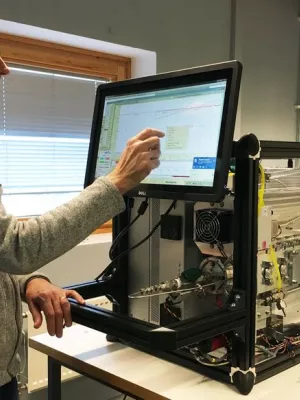
Erik Swietlicki
Professor

Cloud condensation nuclei closure study on summer arctic aerosol
Author
Summary, in English
We present an aerosol - cloud condensation nuclei (CCN) closure study on summer high Arctic aerosol based on measurements that were carried out in 2008 during the Arctic Summer Cloud Ocean Study (ASCOS) on board the Swedish ice breaker Oden. The data presented here were collected during a three-week time period in the pack ice (> 85 degrees N) when the icebreaker Oden was moored to an ice floe and drifted passively during the most biological active period into autumn freeze up conditions. CCN number concentrations were obtained using two CCN counters measuring at different supersaturations. The directly measured CCN number concentration was then compared with a CCN number concentration calculated using both bulk aerosol mass composition data from an aerosol mass spectrometer (AMS) and aerosol number size distributions obtained from a differential mobility particle sizer, assuming kappa-Kohler theory, surface tension of water and an internally mixed aerosol. The last assumption was supported by measurements made with a hygroscopic tandem differential mobility analyzer (HTDMA) for particles > 70 nm. For the two highest measured supersaturations, 0.73 and 0.41 %, closure could not be achieved with the investigated settings concerning hygroscopicity and density. The calculated CCN number concentration was always higher than the measured one for those two supersaturations. This might be caused by a relative larger insoluble organic mass fraction of the smaller particles that activate at these supersaturations, which are thus less good CCN than the larger particles. On average, 36% of the mass measured with the AMS was organic mass. At 0.20, 0.15 and 0.10% supersaturation, closure could be achieved with different combinations of hygroscopic parameters and densities within the uncertainty range of the fit. The best agreement of the calculated CCN number concentration with the observed one was achieved when the organic fraction of the aerosol was treated as nearly water insoluble (kappa(org) = 0.02), leading to a mean total kappa, kappa(tot), of 0.33 +/- 0.13. However, several settings led to closure and kappa(org) = 0.2 is found to be an upper limit at 0.1% supersaturation. kappa(org) <= 0.2 leads to a kappa(tot) range of 0.33 +/- 013 to 0.50 +/- 0.11. Thus, the organic material ranges from being sparingly soluble to effectively insoluble. These results suggest that an increase in organic mass fraction in particles of a certain size would lead to a suppression of the Arctic CCN activity.
Department/s
- Nuclear physics
- MERGE: ModElling the Regional and Global Earth system
Publishing year
2011
Language
English
Pages
11335-11350
Publication/Series
Atmospheric Chemistry and Physics
Volume
11
Issue
22
Document type
Journal article
Publisher
Copernicus GmbH
Topic
- Subatomic Physics
Status
Published
ISBN/ISSN/Other
- ISSN: 1680-7324